People who are in the business of import, export, or foreign trade will often come across this term called ‘Bill of Lading’ during their course of work and during the shipment process. Bill of Lading can be also referred to as BL or BoL or B/L. Bill of Lading is a very important legal document and you need to know everything related to it if you are in the business or involved in the logistics process of import and export.
This documentation process is not very complicated if you understand and follow it correctly. On this web page, we have explained all the important information related to the Bill of Lading like what is a bill of lading? Purpose of a bill of lading? what are the types of bill of lading? what details/ information is there on a bill of lading? Checklist for filling the details in a bill of lading?
Table of Contents
What is Bill of Lading?
Bill of lading which is also called BL or BoL, is an important legal trade document issued by a carrier to a shipper to acknowledge receipt of the cargo for the shipment. BL serves as a shipment receipt that contains the details of the quantity, type, and destination of the goods being carried by the shipper.
A bill of lading serves 3 main purposes –
- It is a legal document of title (ownership) to the goods described in the bill of lading.
- It is a receipt for the shipped products.
- It represents the agreed terms and conditions for the transportation of the goods.
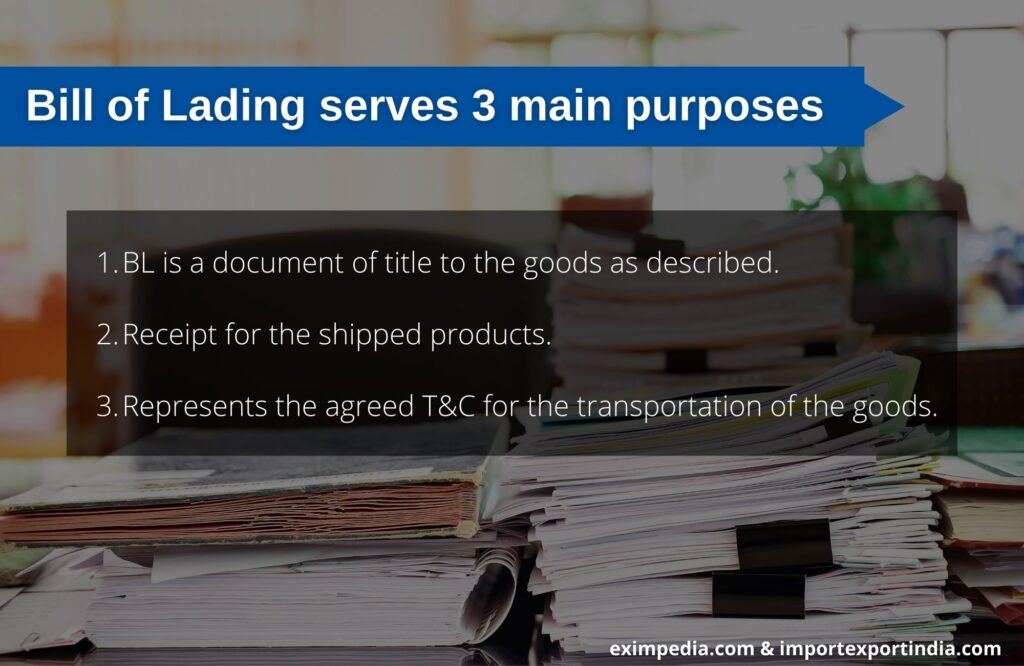
A Bill of Lading (BL or BoL) contains the general information for both the shipper and consignee including, names and addresses of consignor and consignee, name of the carrier, quantities (number of boxes/packages), and type of packaging, specifically cartons, pallets, drums, etc. In the Bill of Lading (BL or BoL), every product must be itemized and include detailed information about the shipment like – unit numbers, weight or volume, and materials used.
BL or BoL has three main functions –
- BL is a document of title to the goods as described.
- Receipt for the shipped products.
- Represents the agreed T&C for the transportation of the goods.
What Information is there on Bill of Lading?
Bill of Lading (BL or BoL) contains detailed information about the shipper (consignor), carrier (transporter), the consignee (buyer/receiver), and the goods being carried.
The following are the details that you will find on the BL:
- BL number
- Name and official address of the shipper and the receiver
- Shipping line details
- Freight forwarder details
- Pick-up date
- Name of the vessel used for transport
- Details of the goods (including the number of units, weight, and dimensions)
- Nature of the goods to be transported
- The packaging material used such as drums, pallets, crates, etc.
- If the nature of goods transported is hazardous, then the BL must have the necessary tags/ necessary certification to allow such transport
- Any other specific/ important instruction for the carrier
- HS Code, Pan number, IEC code, email address of the consignee
Types of Bill of Ladings
- Bill of Lading (BL or BoL)
- House Bill of Lading (HBL)
- Master Bill of Lading (MBL)
- Express Bill of Lading
- Telex Release
- Switch Bill of Lading
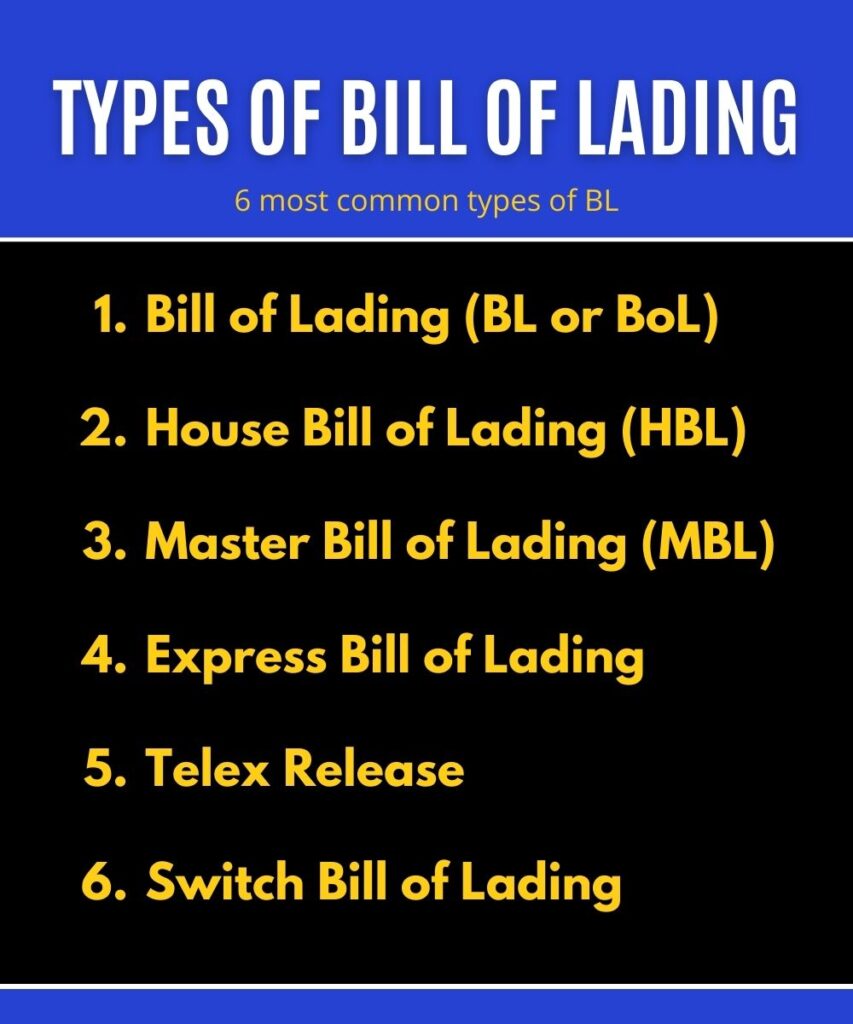
1. Bill of Lading:
This BL or BoL is issued by the shipping carrier to the consigner in sets of originals (usually three sets). The consignee is required to present one of the original Bill of Lading at the shipment’s destination to get the delivery and possession of the goods.
2. House Bill of Lading (HBL):
HBL is issued by the Freight Forwarder to the actual exporter of the goods. A freight forwarder is an intermediary who provides all logistics services to move the goods from their point of origin to their final destination. In HBL, the Shipper will usually be the actual shipper or the exporter of the cargo, the Consignee will usually be the actual receiver or importer of the cargo, and the Notify could be the same as Consignee.
3. Master Bill of Lading (MBL):
MBL is issued by the shipping – carrier to the freight forwarder, who is listed as the shipper, consignee, and notify party. NVOCC stands for Non-Vessel-Operating Common Carrier is someone who undertakes to perform all the services of a shipping carrier but without owning or operating vessels. In the MBL type of bill of lading, the Shipper will usually be the NVOCC operator, or their agent or the Freight Forwarder, the Consignee will usually be the destination agent or counterpart or office of the NVOCC operator, or the Freight Forwarder.
4. Express Bill of Lading:
In this case, the original hard copies of the Bill of Lading are not issued. This is used normally in cases where the shipper and consignee are part of the same company and no negotiations are involved. The express BL is used in the cases where the importer paid for the goods before shipping or the importer has credited with the supplier. The cargo does not need to be released when this type of bill is used since there were no original B/Ls issued. This can save on time and mail courier fees.
5. Telex Release:
This is basically a soft copy of the Original Bill of Lading (BL or BoL) and can be presented at the destination to get the delivery and possession of goods. A Telex release is the industry term for the release of cargo at one port when the original bill of lading has been surrendered.
6. Switch Bill of Lading:
A Switch Bill of Lading is the second set of original BoL issued by the shipping carrier that replaces the original set that was issued at the time of shipment. It is used to edit the info mentioned in the original set of bills. It is intentionally edited which means the switch bill of lading is not meant to be identical to the original Bill of Lading that it replaces.
All the above-mentioned types of BL are the most common and most used as a common practice in the process of import and export by the parties involved in the foreign trade. Apart from this, there are some other types of BL.
For your reference, below is the entire list of Bill of Lading types –
- House Bill of Lading
- Master Bill of Lading
- Through Bill of Lading
- Claused Bill of Lading
- Container Bill of Lading
- Charter Party Bill of Lading
- Multimodal Transport Document/ Combined Transport Document
- Forwarders Bill of Lading
- Stale Bill of Lading
- Short-term/ Blank Back Bill of Lading
- Straight Bill of Lading
- Order Bill of Lading
- Surrender Bill of Lading
- Clean Bill of Lading
- Received for Shipment Bill of Lading
- Bearer Bill of Lading
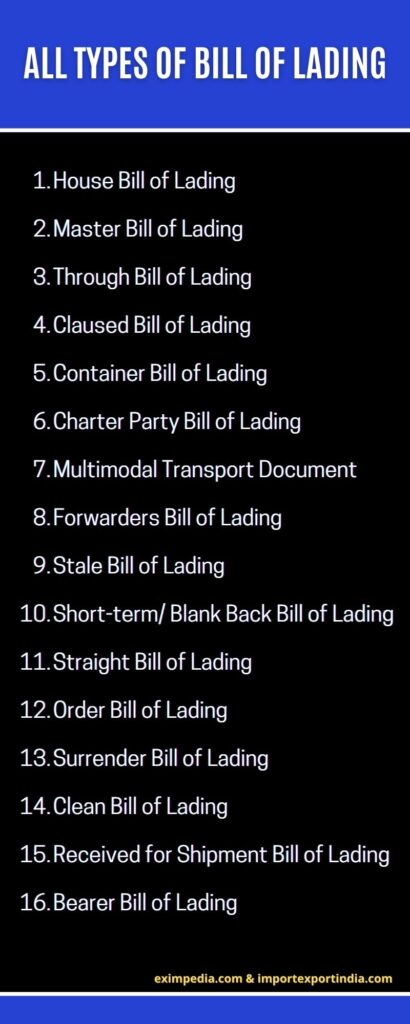
Frequently Asked Questions (FAQs) related to Bill of Lading –
What’s the basic purpose of a Bill of Lading?
BL or BoL has three main purposes/ functions. 1) It is a document of title to the goods described. 2) Receipt for the shipped products. 3) Represents the agreed T&C for the transportation of the goods.
What’s in a Bill of Lading?
Bill of lading is a legal document that is issued by the carrier to the shipper to acknowledge the receipt of cargo for shipment. It also acts as the receipt for the shipment which contains the details of the type, quantity, and destination of the goods being carried.
Who issues Bill of Lading?
Bill of lading is issued by the carrier which is a ship to the shipper/exporter/freight forwarder. For example, The ship belongs to Maersk Shipping Company, so Maersk shipping company will issue a Bill of lading to the shipper/exporter/freight forwarder when they receive the goods from the shipper/exporter/freight forwarder on their ship. Here, Maersk’s ship becomes the carrier.
How many copies of the original Bill of lading are issued?
The carrier issues 3 original bills of lading copies to the shipper/exporter/freight forwarder. One is for the shipper, one is for the consignee, and one is for the broker, banker, or third party. If there are more than 3 copies issued, the number is bills of lading issued should be mentioned on the bill.
When is the Bill of Lading issued?
Bill of lading is issued by the carrier when the goods are loaded onto the vessel/ship for international transit.
When was the bill of lading introduced?
Bill of Lading was introduced – towards the end of the eighteenth century by Lick barrow V. Mason.
Checklist for filling the details in Bill of Lading
- Check all the fields required on the Bill of Lading before filling to enquire and obtain the required information you need. This prevents any possible minor or major mistakes that could happen and what could potentially be costly errors to rectify.
- If in case where you are not sure of certain fields on the BL then check with your freight forwarder.
- Make sure to fill in all required fields accurately.
- Majorly, the details on an original Bill of Lading (BL 0r BoL) will be filled in by the shipping carrier. You need to give information as a supplier to the carrier in advance to make sure that everything mentioned in the BL is correct.
- Double check the information on the draft BL that the carrier/ NVOCC will send to you.
- Check the container and seal number which should match. Always take a pictures of the seal affixed to the container showing the seal number to double check and make sure it is correctly mentioned and clearly visible.
- Make sure that every detail is accurate along with the pre-filled info by the carrier/ NVOCC.
- Recheck and do give attention to the shipper, consignee, and notify party and their detail fields are filled in correctly.
- Mention the contact details of your consignee so that the agent at destination can contact them locally.
- If shipping hazardous materials then clearly label this on your Bill of Lading with all the classifications and related details to it. Do follow the laws and regulations, also obtain all the permits and licenses which are necessary to ship hazardous materials.
- Be very specific in your freight description.
- Number of containers and the no. of goods in each container.
- Value, weight, size, manufacturer and common name etc of the goods.
- Mention all the complete details of the shipment type and number of pallets etc.
- If there are any special shipping instructions, mention them.
- Never mention/ agree for any false information
Important:
The Bill of Lading is an important legal document that can be used as evidence in court if your shipment gets implicated in legal issues. Never mislead by indicating false information, it could lead to delays in shipment and/or payment.
Always send your Bill of Lading by courier service as it provides you with a tracking service. If the Bill of Lading is lost by mistake then it might bring you legal and financial problems.
Before sending the BL, check with your consignee if you should send the complete set of Bill of Ladings (usually three) and if they need to be signed and stamped. In the case of Telex Release or Express Release, if you are using any of them then there will be no need for this as everything will be done digitally.
Role and Need of the Consignee in Bill of Lading :
At the area of shipment or delivery location, the consignee’s employees can use the Bill of Lading to confirm that the shipment delivered to them is correct at meets 100 % of what the company expected. They check the quantity, condition (physical quality), and other details mentioned by their company with the actual shipment/ goods by referring to the information mentioned in the Bill of Lading (BL or BoL). The consignee or its employees could then seek repercussion with the shipper, noting any concerns on the bill of lading. Finally, the consignee or its employees will use the (BL/ BoL) Bill of Lading to sign and confirm receipt of its shipment/ goods as expected by its company.
It is always advisable to appoint/ outsource a customs expert like a custom house agent to manage all the documentation processes. You can delegate the documentation process tasks to a specialized employee or can outsource it to a logistics company or freight forwarder or customs broker who can do the documentation work for you. These service providers have good experience in all the documentation filling and logistics process tasks which will really save your time, effort, and money. Since all the documentation process involves legal binding with the respective country’s law, mistakes made can lead to huge penalties and wastage of time and legal approval.
Please note: There is a lot of difference between theory and practical. Hence, It is always advised to get practical experience in this industry to understand everything in depth.
EXIMPEDIA.COM gives all the information related to import, export, and foreign trade. We at EXIMPEDIA help importers and exporters to start, grow and develop their business by sharing all the updates, news, tips, know-how, business ideas, documentation process, legal process, list of buyers & sellers, exhibition and event updates related to import and export business.
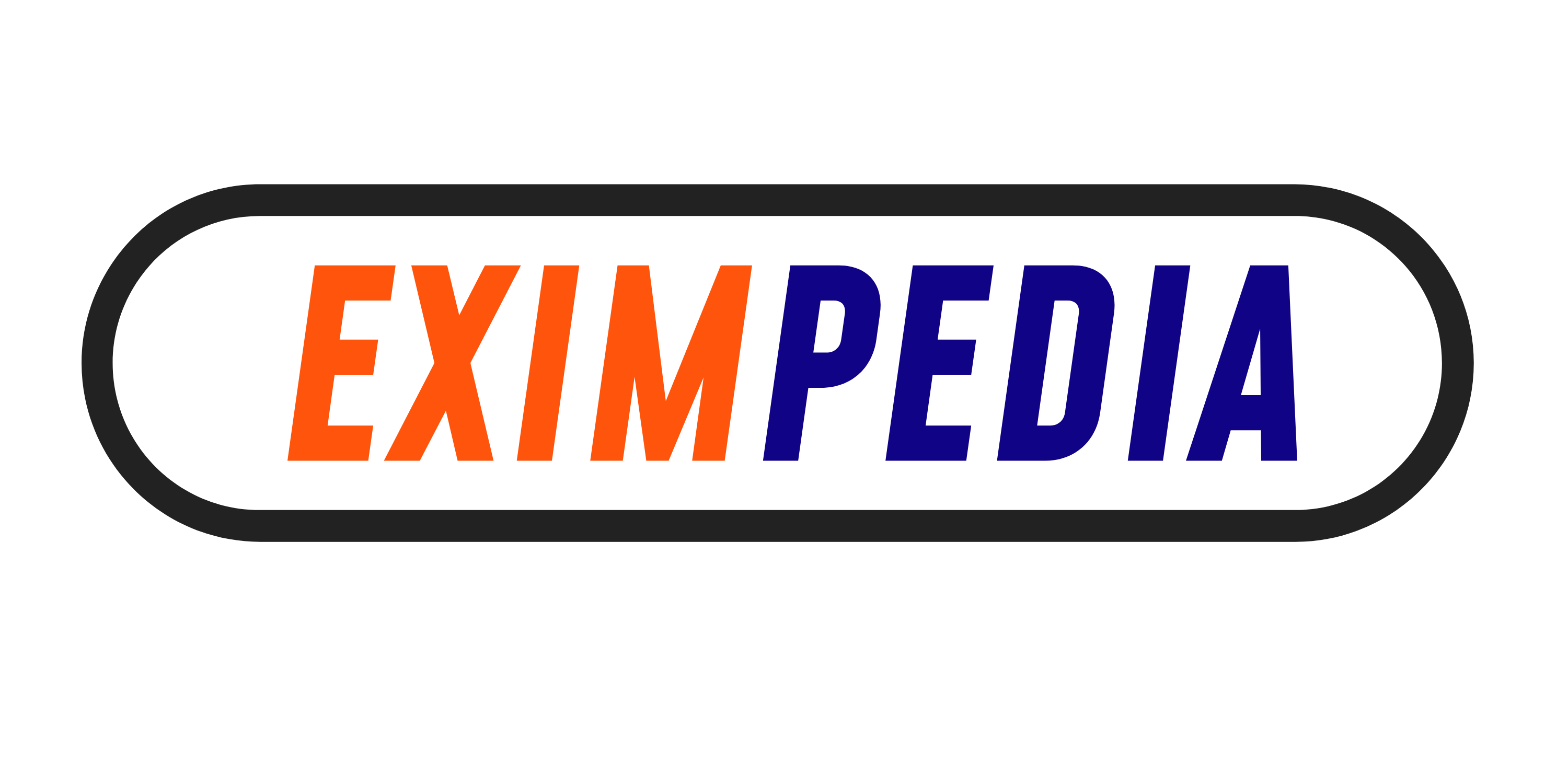
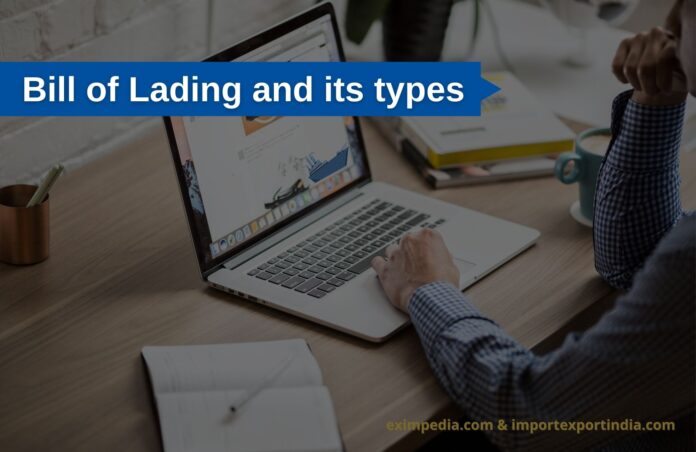






Nice post. I learn something new and challenging on blogs I stumbleupon everyday. It’s always exciting to read through articles from other authors and practice something from their web sites.